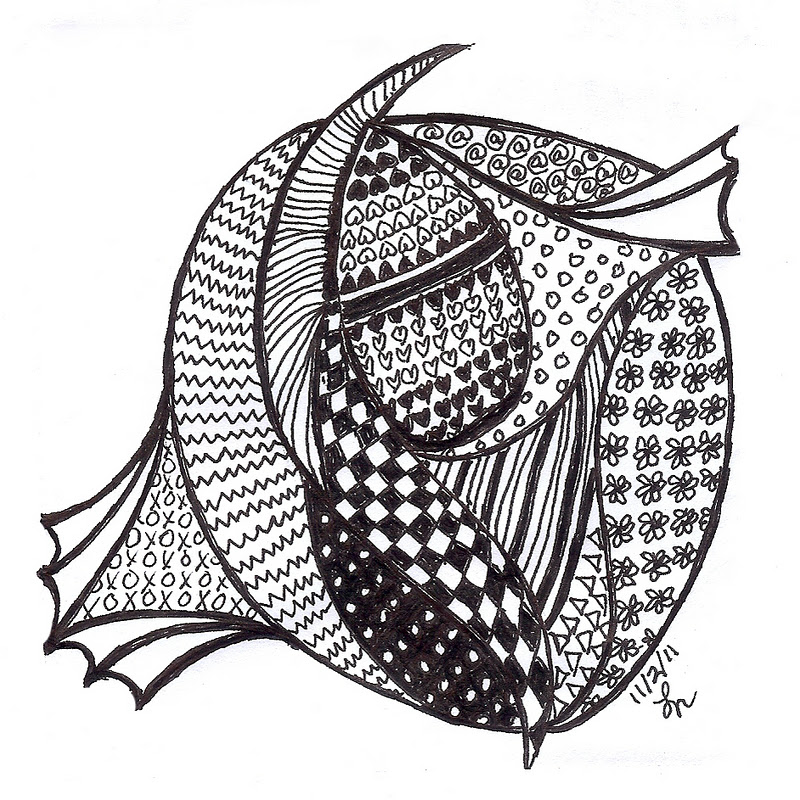The Zentangle® art form and method was created by Rick Roberts and Maria Thomas and is copyrighted. Zentangle® is a registered trademark of Zentangle, Inc. Learn more at zentangle.com.
The hundreds (thousands?) of Zentangle images online make it obvious that I'm late to this arty party, but I'm enjoying it enough that I thought you might like to try it, too. It's relaxing, it can be done anywhere, and it doesn't require a huge investment in supplies. Paper, pen, and pencil are all you need. The experts prefer certain brands and types of those supplies, naturally, but you can use whatever you have on hand to try it out and see if you like it.
Zentangle basically consists of lines and doodled patterns put together on small sheets of paper, and it's incredibly easy (unless you're a perfectionist, that is). The art is in the overall look, not in the individual strokes. Thank goodness, because I mess up a lot of those simple little strokes.
I'm a little embarrassed to put my first efforts up here where you can compare them to some of the strikingly beautiful designs on the rest of the Internet, but I'll do it in the interest of showing you that even a beginner can achieve some interesting effects. With two exceptions, these are the only ones I've drawn, and they're posted in the order in which they were drawn. One exception is my favorite so far, and I've saved it for the end of this post. It isn't necessarily the best of the lot, but, for reasons I'll explain, it holds more meaning than the other ones. The other exception (I think it was the sixth one I drew) was messed up beyond repair, so I cut it out of my sketchbook and threw it in the garbage. (If you think a one-out-of-nine reject rate is too high for a novice, you should have seen some of the failures I created on earlier projects.)
Oh, another thing: I usually encourage you to click on my posted images to enlarge them and see them in greater detail. Not so in this case. Enlarge this set of images only if you want a close-up look at the hundreds of imperfections in these drawings. Sometimes, it seems, smaller images are more forgiving.
_____________________________________

_____________________________________
_____________________________________
_____________________________________
_____________________________________
_____________________________________
_____________________________________
_____________________________________
One more thing I found interesting was that after I had done only a couple of these designs, I started noticing patterns in my environment where I'd never seen them before. There were patterns everywhere, and it was fun to see them pop out at me after years of blending in with the scenery.
The following drawing is my favorite because I sat in my living room and picked out patterns I could see from right there on the end of the sofa. The connected black squares at the upper left (they're black squares, not white crosses) represent a wall hanging made of laquered metal squares connected by black bars. The top center design is my version of tall dried vines that stand in a vase near a doorway. Next to the vines is a silk philodendron, bordered on the right by a pair of drawer handles. Underneath the drawer handles sits a patch of rattan from the baskets under my coffee table. Below the rattan there are four pine cones like those piled up in a dish on the coffee table (except when Levi messes with them). At the bottom right is a design cast into a bronze lamp base. The shape at the bottom left is a curved chair arm with its nailhead trim. The pattern of the actual chair consists of narrow stripes similar to those shown in the center of this chair-arm shape. For the outermost portion of the chair arm, I repeated the amoebic shape of a single large leaf from a botanical print on my wall. See what I mean about patterns everywhere?








Interesting-I see what you mean about the overall pattern, not the individual lines-when I clicked to enlarge, they didn't look as good when I could see the individual lines.
ReplyDeleteI like how you incorporated things you could see from your seat into your design. It's kind of like a code!
I'll give it a try when I get some quiet time, which might not be for a while. :-p
Janet, the actual drawings are small, under four inches on each side. I'm sure there are people with better eyesight and steadier hands than mine whose enlargements would look just fine. I think my overall designs will get better with practice, but my individual strokes and dark fill-ins probably won't.
ReplyDeleteFortunately, I've had enough life experience that my world no longer falls apart when I make mistakes. Boy, did that take a long time to learn.
I really like these. I hadn't heard of this before and am looking forward to trying it. I think yours look good, and I like the idea of putting them all together...there's no stopping once you start, I imagine. At least, that's the way it would be with me!
ReplyDeleteIt sounds really meditative...I like Janet's idea of your last one having a code. The first two look like birds to me..xx
Marion, I'm glad you're going to try this. I know from seeing the face sketches you posted the other day that you have some natural artistic talent, so Zentangling should be easy for you. It is meditative--and also hard to put down once you get in that "zone."
ReplyDeleteYour first efforts are wonderful -- I've been wanting to try this.
ReplyDeleteVicki, thanks, but if I had the imagination to write mysteries the way you do, I wouldn't be wasting my time doodling. On second thought, the zen quality of this activity might free your mind to work out the kinks in plot points.
ReplyDelete